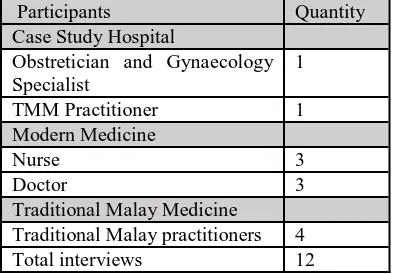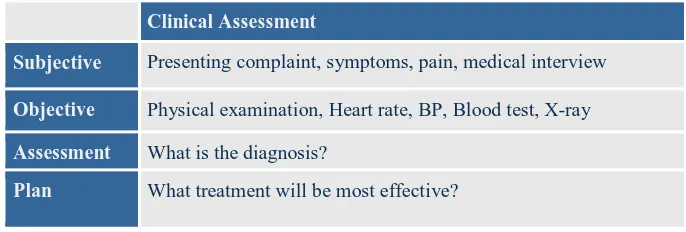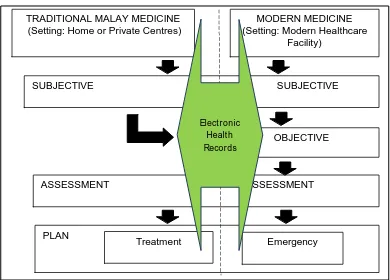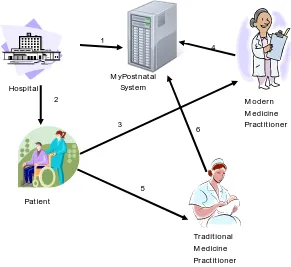ISSN 0973-4562 Volume 10, Number 2 (2015) pp. 4939-4947 © Research India Publications
http://www.ripublication.com
A Framework for Integrated Postnatal Care Services for
Traditional Malay Medicine and Modern Medicine
Raja Rina Raja Ikram1, MohdKhanapiAbdGhani. 2
Biomedical Computing and Engineering Technologies (BIOCORE Malaysia) Applied Research Group, UniversitiTeknikal Malaysia Melaka, Hang Tuah Jaya, 76100,
Durian Tunggal, Melaka, Malaysia 1,2
E-mail: rajarina@gmail.com 1*Corresponding author Telephone: +60132080043 1
E-mail: khanapi@utem.edu.my 2
Abstract
This paper shall propose aframework to integrate the services of Traditional Malay Medicine (TMM) with modern medicine in the field of postnatal care. A semi structured interview was conducted towards twelve postnatal care practitioners in the traditional malay medicine and modern medicine field and one public hospital in Malaysia. The current framework shows that both medicine systems are being treated in isolation of each other. MyPostnatal framework is proposed to integrate the services of these medicine systems via electronic health records.Patient can access integrated healthcare services seamlessly and holistically without isolation. Healthcare providers shall also benefit from the standardization of information exchange with other healthcare providers.
Introduction
Kuala Terengganu, Sarawak General Hospital, Port Dickson Hospital in Negeri Sembilan, SultanahBahiyah Hospital in AlorSetar Kedah and Cameron Highlands Hospital (Abuduli & Aljunid, 2011). These hospitals practice traditional Malay massage, acupuncture, herbal oncology and postnatal massage (Health, 2007).
Traditional Malay massage and acupuncture are used for chronic pain and stroke; herbal oncology is used for complement treatment with allopathy therapy whereas postnatal massage is used to relieve muscle cramps and fatigue after labour(Abuduli & Aljunid, 2011) .
Even though Traditional Malay Medicine is practiced in nine hospitals, majority of the TMM practice is limited to Traditional Malay massage. However, the Traditional & Complementary Medicine (T&CM) Unit of Putrajaya Hospital and Johor Baru's Sultan Ismail Hospital midwifery care practices hot compress or
bertungku and herbal body wrap or bengkungand Malay postnatal massage
(Barakbah, 2007). Traditional Malay massage is part of the processes involved in Malay Confinement. Malay Confinement is essentially an all-encompassing process that aims to preserve the health and femininity of Malay women. According to Datin Sharifah Anisah, founder of Nona Roguy (now NR) and author of “EnsiklopediaPerbidananMelayu”(Encyclopedia of Malay Midwifery) (Barakbah, 2007), confinement practices stem from the belief that the womb is a woman's life force and affects her overall health (Barakbah, 2007). There are also many Malay Confinement centres for mothers to rehabilitate and rest after childbirth, including Confinement lady services providing Malay Confinement services from home. Today, many urban new mothers in the Malay community find themselves unable to fully observe the practices of the traditional Confinement, mainly because they lack the family and community support that made Malay Confinement possible. However, some practices are still observed by many Malay women. Some have been adapted to suit more urban lifestyles. Among the Malay Confinement commonly practiced are
bengkung (the traditional wrap or girdle), postnatal massage, jamu (traditional made
supplements), hot compress and herbal baths(Barakbah, 2007). These complete Malay Confinement practises are not fully implemented by Malaysia’s official healthcare system or government hospitals. However it is supported by many private and individual confinement care services that provide this alternative for new mothers. Thus, there is an isolation of Malay Confinement implementation in the government or official healthcare system and private hospitals or wellness centres. Private hospitals that implement midwives for home visits also would usually outsource the Malay Confinement practices to individual midwives without proper documentation of health records.
The Problem And Its Context
treatment (TCM Division, 2009) in pilot hospitals. However, literature regarding development of information technology to support TMM was unable to be obtained in this study which leaves a huge research gap to be filled in this domain. Figure 1 shows that there is no overlap between the information technology and TMM subset, implying that opportunities of research are huge to leverage information technology in the TMM domain.
Figure 1: Information Technology gap in the domain of Traditional Malay Medicine
This research shall attempt to reduce this information technology gap by proposing a framework to integrate modern medicine and Traditional Malay Medicine in a selected research domain i.e. postnatal care.
Methodology
A semi structured interview was conducted via participants in the postnatal care treatment – nurses, doctors and Traditional Malay Medicine practitioners. The questions of structured interview can be referred at Appendix 1 Section B. The main questions that were included interview are
1) Are computerized systems used to manage Malay postnatal services? Please specify the scope of computerized systems used if any.
2) What is the current procedure for a patient to undergo Malay postnatal treatment?
3) What factors encourage modern medical practitioners refer patients to undergo Malay postnatal treatment?
4) What factors will trigger Malay postnatal patients to refer to medical practitioners?
A literature review was also conducted on existing frameworks available. Amongst the main reference is the Malay Postnatal Care Practices in Hospital Setting developed by Ministry of Health, Malaysia(TCM Division, 2009).
A total of 12 interviews were conducted. Structured interviews involved participants that represent 1 hospital, 3 nurses, 3 medical officers and 4 Traditional Malay Medicine practitioners. The population of Traditional Malay Medicine
Informat ion Technology Tradit ional M alay
M edicine
M odern M edicine
practitioners in Malaysia is unable to be accurately established as these providers are not entirely regulated and may only exist though referral by neighborhood or family contacts.
Participants Quantity
Case Study Hospital
Obstretician and Gynaecology Specialist
1
TMM Practitioner 1
Modern Medicine
Nurse 3
Doctor 3
Traditional Malay Medicine Traditional Malay practitioners 4
Total interviews 12
Table 1: Participants involved in the data collection process
Table 1 shows the breakdown of the interview participants involved in the study. The hospital selected are one of the 2 pilot public hospitals in Malaysia that implement Traditional Malay postnatal massage and postnatal care as part of the services in their traditional and complementary medicine unit facility. Nurses involved in this study are well trained in the field of maternity care. Medical officers selected in this study consists of mothers who are experienced in implementing Malay postnatal practices during their self-confinement period. Traditional Malay Medicine practitioners involved all have a minimum of 10 years of experience in Malay postnatal care services and their services are well sought in their respective residence communities.
Results
Figure 2 Isolation of patient consultation health records based on the SOAP model.
Figure 2 shows the isolation of patient consultation when they seek treatment from either a TMM practitioner or a modern medicine practitioner. The current framework can be divided into four process steps: Subjective, Objective, Assessment and Plan. A guideline on the elements of the model can be referred to in Table 2.
Clinical Assessment
Subjective Presenting complaint, symptoms, pain, medical interview
Objective Physical examination, Heart rate, BP, Blood test, X-ray
Assessment What is the diagnosis?
Plan What treatment will be most effective?
Table 2: The S.O.A.P. Model for Clinical Health Assessment (NM-IBIS, 2014)
The SOAP model for clinical and community health assessment is a model that provides a structural method used by healthcare providers to document a patients chart (NM-IBIS, 2014)(NM-IBIS, 2014) during doctor patient consultation. This model is used to compare doctor patient consultation process between Traditional Malay Medicine and modern medicine system. S.O.A.P. model consists of four parts that are Subjective, Objective, Assessment and Plan (NM-IBIS, 2014). Subjective is the evaluation of patient condition or describes the reasons they visited the physician. This includes onset, chronology of symptoms, severity, factors aggravating or reducing, and previous treatments. Objective is the documentation of patient condition through physical examinations, vital signs, results from laboratories which usually involves results of measurable data. Assessment is the analyses of subjective
PLAN
MODERN MEDICINE TRADITIONAL MALAY MEDICINE
SUBJECTIVE
OBJECTIVE
ASSESSMENT
and objective information of the physicians diagnosis. Plan is the treatment of the patient which may include referrals, procedures, prescriptions.
According to Figure 2, since TMM practitioners are not qualified to perform objective tests, patient is highly recommended to refer to a qualified medical practitioner for a thorough examination before a comprehensive assessment can be executed. Both TMM and modern medicine practitioners offer treatment, the treatment offered by both is segregated and isolated. Modern medicine practitioner can only provide emergency related health problems where as TMM practitioners provide TMM postnatal treatment. Both these treatment complements each other and is considered a more holistic treatment for the patient. Based on the framework in Figure 2, the doctor consultation process model is not complete or thorough because relevant physical examinations that require qualified medical officers to execute cannot be completed by the TMM practitioner. The patient can only be physically assessed if a certified modern medical officer is present in the premise or patient seek this diagnosis at modern healthcare facilities. Thus there is a need to integrate the services of TMM and modern medicine. The next section shall propose a framework that can solve the current problem.
Proposed Framework
Figure 3: Proposed MyPostnatal Framework
PLAN
MODERN MEDICINE (Setting: Modern Healthcare
Facility) TRADITIONAL MALAY MEDICINE
(Setting: Home or Private Centres)
SUBJECTIVE SUBJECTIVE
OBJECTIVE
ASSESSMENT ASSESSMENT
Emergency Treatment
Figure 3 portrays the proposed framework. Patients seeking postnatal treatment shall be required to get their physical examination and vital signs checked in the nearest healthcare facility before attempting any treatment. The process flow in Figure 3 shows the objective stage being conducted in a modern healthcare facility by modern medicine practitioners only. This stage is vital to check whether a patient is suitable to undergo Traditional Malay Medicine postnatal treatment. Assessment stage can be completed by both TMM and modern medicine practitioner as both practitioners are required to assess patient’s suitability towards the treatment. TMM treatment can be performed by TMM practitioners at any home or private centres. Emergency treatment is defined as adult or pediatric with acute illness or injury that require immediate medical attention. Emergency treatment can only be provided in modern healthcare facilities if a patient shows relevant symptoms. These treatments which have been done in isolation shall be integrated via electronic health records. The following diagrams represents the process flow of MyPostnatal framework.
Figure 4. MyPostnatal framework process flow
1) Hospital updates patient health record in MyPostnatal with postpartum details. 2) Hospital discharges patient.
3) Patient seeks modern medicine practitioner for postnatal follow up treatment. 4) Modern medicine practitioner updates MyPostnatal with patient health
records.
5) Patient seeks TMM practitioner for TMM postnatal treatment.
Pat ient
M odern M edicine Pract it ioner
Tradit ional M edicine Pract it ioner Hospit al
1
2
3
4
5
6 M yPost nat al
6) TMM practitioner retrieves patient health record of previous visit to modern medicine practitioner to assess patient suitability for treatment. TMM practitioner than updates MyPostnatal system with patient treatment details.
Advantages Of Proposed Framework
The proposed MyPostnatal framework has a few advantages compared to the existing framework. Patient can access integrated healthcare services seamlessly and holistically without isolation of services. This framework also promotes Malay postnatal good practices to Malay medicine practitioners. Malay women who are the main users of postnatal treatment shall benefit from availability information to compare services delivered by providers. Healthcare providers shall benefit from the standardization of information exchange with other healthcare providers.
Conclusion
This paper has described the proposed MyPostnatal framework and process flow.MyPostnatal framework leverages electronic health records to integrate Traditional Malay Medicine and modern medicine.This framework shall provide a guideline to assist the healthcare community to standardize and promote understanding of best practices of postnatal treatment in the Traditional Malay Medicine field. Traditional Malay Medicine in postnatal care should be recognized as part of an evidence based medical treatment with proper healthcare record documentation.
References
1] Abd Jalil, M. A., Shuid, A. N., & Muhammad, N. (2012). Role of medicinal plants and natural products on osteoporotic fracture healing. Evidence-Based
Complementary and Alternative Medicine: eCAM, 2012, 1–7. doi:10.1155/2012/714512
2] Abuduli, M., & Aljunid, S. (2011). Role of Traditional and Complementary Medicine in Universal Coverage. Malaysian Journal of Public Health
Medicine, 11(2), 1–5.
3] Barakbah, A. (2007). Ensiklopedia Perbidanan Melayu. Utusan Publications
and Distributors (First Edit., p. 350). Kuala Lumpur: Utusan Publications and
Distributors.
4] Health, T. U. M. of. (2007). Portal Rasmi Bahagian Perubatan Tradisional dan Komplementari -. Retrieved November 17, 2014, from http://tcm.moh.gov.my/v4/bmelayu/modules/mastop_publish/?tac=67
5] Keat, A., & Boon, T. (2007). Effect Of Kacip Fatimah ( Labisia Pumila ) Water Extract On Mammographic Density -- A Pilot Study. Malaysian
6] NM-IBIS. (2014). SOAP Model for Community Health Assessment.
Retrieved November 17, 2014, from
https://ibis.health.state.nm.us/resources/SOAP.html
7] TCM Division, M. of H. M. (2009). Guideline for Malay Postnatal Care.
Retrieved November 17, 2014, from




